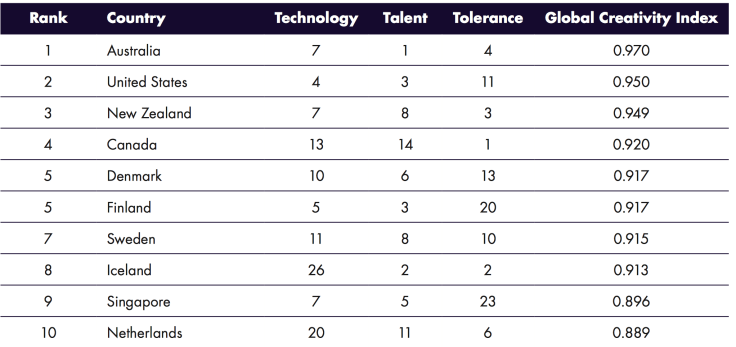Global Creativity Index Measures Tech, Talent, And Tolerance: These Are The Most Creative Countries In The World

What makes someone creative? One might say it has to do with imagination, the ability to think things up on the spot or create worlds only found in long-forgotten dreams. If that’s a person, what makes a country creative? According to a new study, it’s talent, technology, and tolerance.
The study was compiled by the Martin Prosperity Institute (MPI) at the University of Toronto, with the aim of deciding which of the 196 countries of the world is the most creative. Using what they dubbed the Global Creativity Index (GCI), researchers defined creativity as the “three T’s”: talent, technology, and tolerance.
Technology rankings were based on investment levels in research and development, plus how many patent applications per capita each country had.
Talent was evaluated by using a composite of the percentage of adults who owned an advanced degree, as well as the percentage of the workforce that had jobs in the creative industry.
Rankings for the third factor, tolerance, were found based on how each country treated their immigrants, the diversity of the racial and ethnic minorities, and how many LGBT residents were in each country.
To obtain their rankings, the researchers analyzed 139 countries, with many countries of low economic status being left off the list as complete data couldn’t be sourced, and ranked them in each category. Overall creativity was determined by each country’s ranking across the T’s, then divided by the total observations made in each category patent applications per capita, creative-class measure, etc.
Australia was found to be the most creative, with a global ranking of 1 in talent, 4 in tolerance, and 7 in technology. The U.S. was ranked second while being 3rd in talent, 4th in technology and 11th in tolerance. Australia’s close neighbor New Zealand came in 3rd, as it was 3rd in tolerance, 7th in tech, and 8th in talent.

“The GCI is closely associated with key measures of economic and social progress. Nations that score highly on the GCI have higher levels of economic output, entrepreneurship, economic competitiveness, and overall human development,” the report concluded. “Creativity is also closely associated with urbanization, with more urbanized nations scoring higher on the GCI.”
The researchers also claimed to have found a link between social equality and creativity, especially in the countries that ranked high on the GCI. “While some countries, like the United States and the United Kingdom, achieve high GCI scores alongside relatively high levels of inequality, generally speaking, higher levels of global creativity are associated with lower levels of inequality.”



























